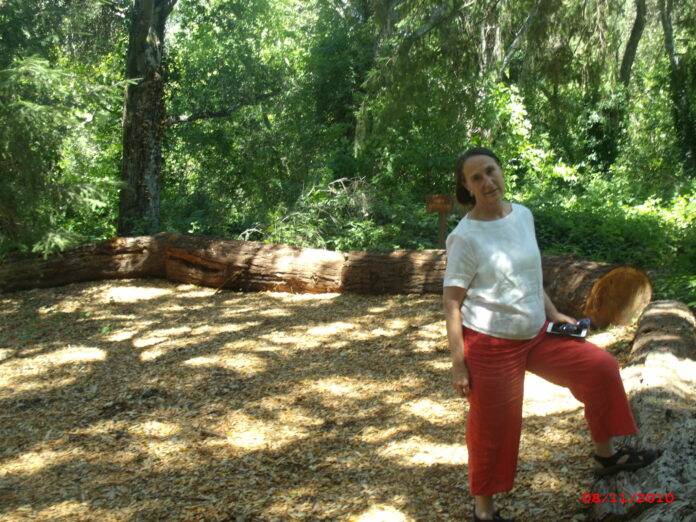Linda Skeff is on a mission- to eradicate invasive species and restore native plant habitat up and down the San Lorenzo Valley. After three years of leading teams of AmeriCorps Volunteers to “pull out the invasive and restore the natives”, Skeff has her sights on a nearer term goal than the whole valley, but no less ambitious.
“I’d like to remove the invasives to restore a wildlife corridor of native habitat between the two parks- from Big Basin State Park all the way to Henry Cowell State Park,” Skeff said.
Skeff is director of the San Lorenzo Valley Native Habitat Restoration Program, one of the premier programs under the umbrella of the Environmental Committee of the Valley Women’s Club. Skeff initiated collaboration with AmeriCorps Volunteers for this program, a federally-funded volunteer organization for 18-24 year-olds, by creating a work and educational program focused on the importance of native habitat restoration.
Skeff sees the restoration of native habitat as much more than simply improving the landscape of isolated projects; she sees it as critical to restoring the overall health and vibrancy of the San Lorenzo Valley watershed.
“It all begins with the plants; once you clear away the invasives and make it so the native plants can come back, the animals- the birds, the insects and other species- they all begin to come back,” Skeff said. “But it can’t happen on its own. The invasive kill the natives and before long the entire native ecosystem is gone.”
Having led teams of 10 to 12 AmeriCorps Volunteers in intensive, full-time, 14-week project schedules between January and April for the last three years, the Native Habitat Restoration Program is beginning to realize some real results. Significant work has been completed at Quail Hollow County Park, Highlands County Park, including restoration projects around the Senior Citizen’s Center at Highlands Park, as well as several projects for the Boulder Creek Recreation and Parks District, and a few nonprofit organizations such a Mountain Community Resources.
According to Skeff, one of the guiding principles of the Native Habitat Restoration Program is to “demonstrate to the community how to integrate the needs of the community with the needs of native habitat,” Skeff said.
Skeff explains the public value of some of the completed projects completed in terms of “living frescoes” that demonstrate to the public the advantages of restoring native plant habitat. A prime example is the cleared and deeply chipped community sitting area under oak trees close to the Senior Center at Highlands Park, which was previously overrun with Ivy Vinka and non-native blackberry. Skeff explains this project as a good example of serving community needs as well the needs of native habitat, and now serves as a demonstration site for community education.
As much as actually pulling out invasive plants and restoring native habitat is the objective, Skeff emphasizes that building the local social infrastructure by fostering ties with as many local community organizations as possible, and educating the public on what they can and should do, is equally important.
The emphasis on building community engagement was shown this last year by engaging the AmeriCorps Volunteers, with the help of a graphic designer, in developing a series of “project boards” that described the work at each site. The “project boards” are designed as public education graphics of what native habitat restoration looks like in the field, and how beneficial it is to birds and other wildlife. The “project boards” have been used promote the community commitment necessary to eradicating invasive species at public events and public education forums.
Because AmeriCorps Volunteers can be assigned to community projects for a maximum of five years in a row, Skeff explains the emphasis on community outreach and engagement will be stronger than ever in the next two years. Skeff hopes to replace the AmeriCorps Volunteers with local volunteers from local organizations. But Skeff also aims to educate and encourage regular homeowners to become aware of the value of native habitat, and work their own property accordingly.
Skeff uses the example of the oaks shading the “deeply chipped” community area at the Highland Park Senior Center. “Many people have beautiful old oaks on their property, but don’t necessarily know how oaks really want to live. This is the way oaks want to live- without invasive blackberry and ivy strangling them and the soil, without any lawn, and with a cleared area underneath, in which other native species can thrive,” Skeff said.
Keeping the invasives out, without herbicides, is another valuable lesson the “restoration” program hopes to promote, which is also demonstrated at the Highlands Park Senior Center. After a site is cleared of the invasive weeds, ivy, blackberry and Scotch or French Broom, large sections are covered with cardboard from Costco and then overlaid with a deep layer of wood chips. In about one year, the cardboard will have disintegrated, the “weed bank” of invasive plants seeds will be exhausted, and the soil will be ready for native plants, eliminating the need for weed whipping, Skeff explained while showing the project areas around the Senior Center.
Skeff discussed plans and projects for the next year at a meeting of the Environmental Committee of the Valley Women’s Club on July 9th, which meets regularly the first Saturday of each month in the community room next to the Nature Store at Henry Cowell Redwood State Park, which are open to the public. More information about the Native Habitat Restoration Program can be found at: https://www.facebook.com/slvrestorationprogram/











